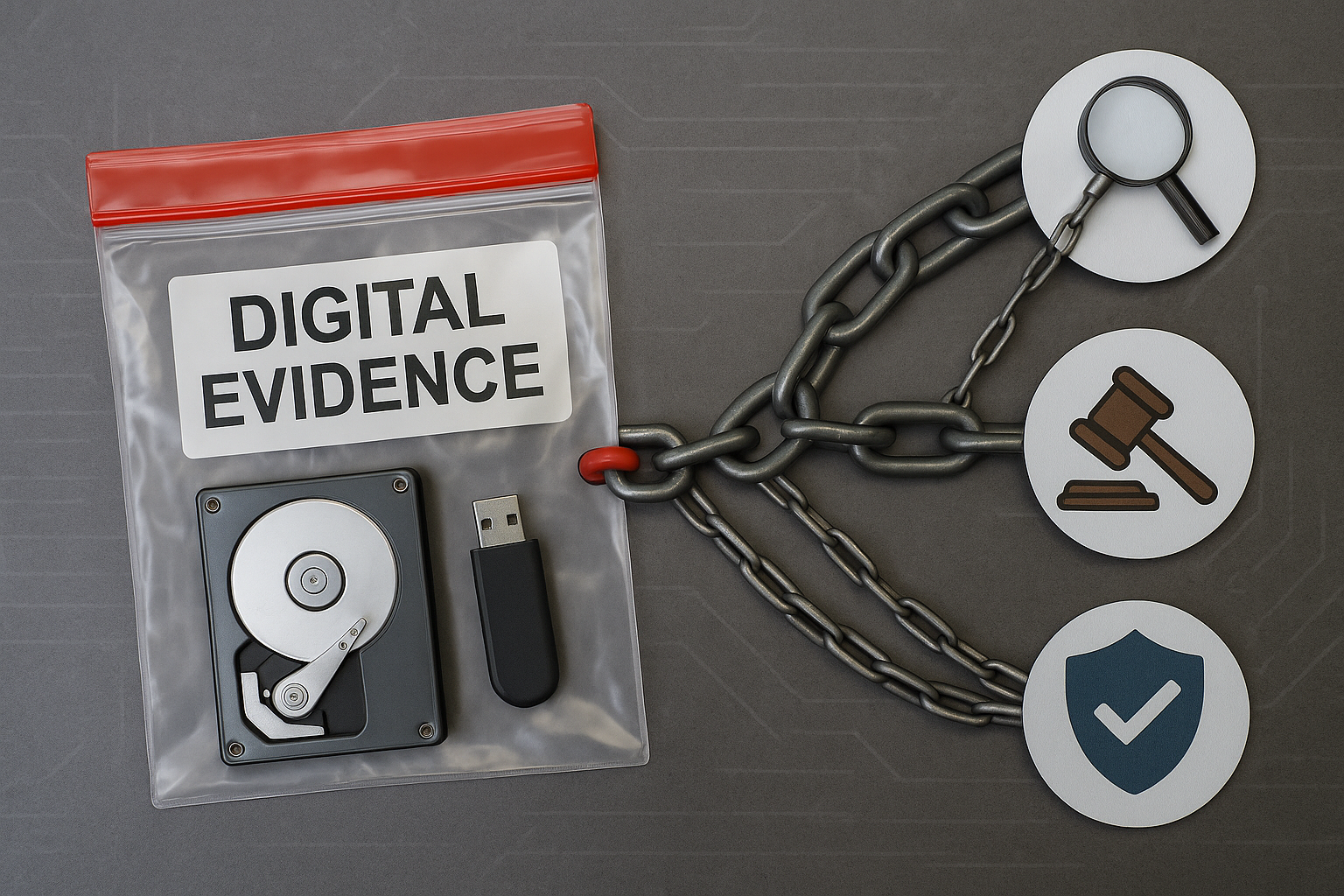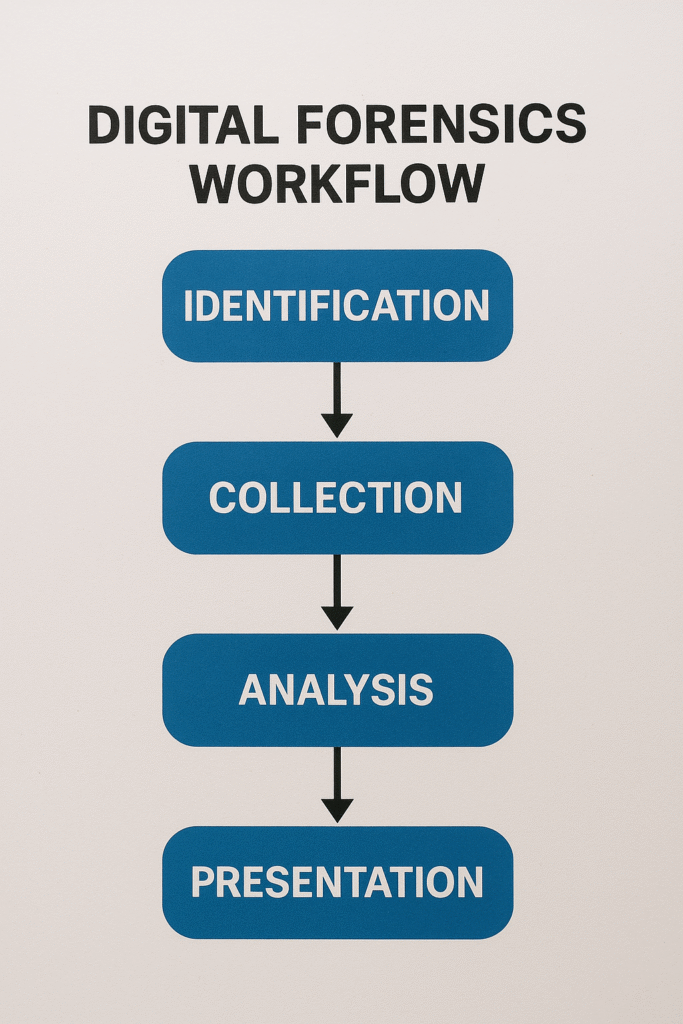
A well-maintained Chain of Custody in Digital Investigations is critical for legal admissibility and forensic integrity.
In today’s digital age, data is often at the heart of investigations—from criminal cases and civil lawsuits to cybersecurity breaches and corporate fraud. When digital evidence plays a central role, maintaining a proper chain of custody becomes essential. Without it, even the most compelling digital proof can be deemed inadmissible in court, or worse, compromised beyond recovery.
But what exactly is the chain of custody in a digital context, and why does it matter so much? Let’s dive deep into this foundational principle of digital forensics and explain its growing importance in both legal and enterprise environments.
What is Chain of Custody in Digital Forensics?
The chain of custody refers to a chronological and documented trail that records the seizure, custody, control, transfer, analysis, and disposition of evidence—specifically, digital evidence in this context. It provides a clear, traceable history of who accessed the data, how it was handled, where it was stored, and whether it remained unchanged.
In digital investigations, the goal is to prove that the evidence was collected and preserved in a way that ensures its authenticity and integrity. Any break in this chain—or failure to properly document any step—can lead to the evidence being thrown out, questioned, or discredited.
Why the Chain of Custody in Digital Investigations Matters

1. Protects the Integrity of Digital Evidence
Digital data is inherently volatile and easy to alter, even unintentionally. A solid chain of custody ensures that from the moment evidence is collected, its integrity is preserved through verifiable methods. This includes using write-blockers, generating hash values (like MD5 or SHA-256), and logging all interactions with the evidence.
Even something as simple as accessing a file without read-only protections can modify metadata—potentially compromising the case.
2. Ensures Legal Admissibility
Courts operate under strict standards when it comes to admitting evidence. If the chain of custody is incomplete, unclear, or inconsistent, defense teams can argue that the evidence may have been tampered with or contaminated. In high-stakes legal battles, this could be a game-changer.
This is why establishing a clear Chain of Custody in Digital Investigations is not just helpful—it’s absolutely essential in court proceedings.
3. Establishes Accountability
Every person who comes into contact with the digital evidence must be accounted for. Whether it’s an IT administrator, forensic analyst, or legal counsel, the chain of custody holds each party responsible. It documents the who, what, when, where, and why—making it easier to pinpoint where any potential mishandling may have occurred.
4. Prevents Tampering and Fraud
A well-maintained chain of custody acts as a deterrent to tampering. Knowing that every interaction is being logged discourages malicious intent or accidental mishandling. It’s not just a best practice—it’s a legal safeguard.
Key Components of a Digital Chain of Custody
Creating and maintaining an effective chain of custody involves several core components:
1. Identification and Collection
- Each digital asset (e.g., hard drive, USB, cloud storage) must be uniquely identified.
- Digital tools like EnCase or FTK Imager are used to acquire a forensic image—a bit-by-bit copy—without altering the original data.
2. Documentation and Logging
- Every action taken on the evidence is meticulously documented.
- Timestamps, handler names, purpose of access, and changes (if any) are recorded.
- Many organizations use automated evidence management systems to help with this.
3. Secure Storage and Transfer
- Digital evidence must be stored in secure, access-controlled environments.
- During transfer, both physical and digital means must be secured, often using encryption or tamper-proof packaging.
- Proper encryption methods must be enforced to secure the Chain of Custody in Digital Investigations during physical or cloud-based transfers.
4. Hash Verification
- Before and after each interaction, hash values are generated to confirm that the file has not changed.
- A mismatch in hash values would indicate potential tampering.
5. Controlled Access
- Only authorized personnel can access the evidence.
- Access must be logged, and multi-factor authentication is often required.
Best Practices for Preserving Chain of Custody
Maintaining an effective chain of custody requires a combination of technology, process, and training.
These steps reinforce the overall strength of the Chain of Custody in Digital Investigations and prevent any gaps in the handling process.
Here are some best practices:
- ✅ Always use forensic-grade tools for data acquisition.
- ✅ Train staff on proper evidence handling protocols.
- ✅ Maintain a centralized log system for chain of custody records.
- ✅ Perform regular audits of evidence handling procedures.
- ✅ Implement role-based access controls (RBAC) and encryption for stored data.
- ✅ Use hashing algorithms and verify checksums at every step.
Real-Life Examples of Chain of Custody Failures
Understanding the risks of ignoring the chain of custody can be eye-opening. Let’s look at two real-life scenarios:
❌ Enron Email Scandal
During the investigation into Enron’s financial practices, digital emails were submitted as evidence. However, inconsistencies in documentation and lack of a clear chain of custody led to delays and doubts about the evidence’s authenticity.
❌ BTK Killer Case (Early Investigations)
In the initial investigations into the BTK serial killer, physical and digital evidence was lost due to poor handling procedures and an undocumented chain of custody. This resulted in years of delay in catching the perpetrator.
In both cases, a strong chain of custody could have expedited justice and prevented public distrust.
Chain of Custody in Corporate and Cybersecurity Contexts
While often discussed in legal or law enforcement contexts, chain of custody is equally important in corporate investigations, including:
- Cybersecurity breaches
- Insider threats
- Data loss prevention
- Employee misconduct
- Intellectual property theft
Organizations conducting internal audits or responding to cyber incidents must ensure that digital logs, network traffic data, and file evidence are collected and handled according to chain of custody protocols. This not only protects the organization legally but also supports compliance with regulations like GDPR, HIPAA, and SOX.
Maintaining the Chain of Custody in Digital Investigations also helps in meeting the cybersecurity standards required by international regulations.
Tools Commonly Used in Chain of Custody
To help enforce chain of custody in digital forensics, the following tools are widely used:
- FTK Imager: For creating forensic images.
- EnCase Forensic: Comprehensive case management and chain of custody tracking.
- Autopsy: Open-source forensic platform with integrated evidence logging.
- Magnet AXIOM: Used for digital evidence recovery and documentation.
These tools often come with built-in features for chain of custody management, such as logging, hashing, and secure storage.
For best practices, refer to the official NIST Digital Evidence Guidelines.
Conclusion
Ultimately, a reliable Chain of Custody in Digital Investigations is what transforms digital evidence from risky to reliable.
The chain of custody is not just a procedural requirement—it’s a cornerstone of digital investigations. Whether you’re investigating cybercrime, conducting internal audits, or managing electronic discovery in a lawsuit, ensuring the authenticity, integrity, and admissibility of digital evidence depends on a secure and well-documented chain of custody.
In an age where data can be easily duplicated, deleted, or altered, a robust chain of custody builds trust, enhances transparency, and upholds justice. As digital evidence continues to play a central role in modern investigations, prioritizing chain of custody is not optional—it’s essential.
Frequently Asked Questions (FAQs)
Q1: What is the difference between digital and physical chain of custody?
A1: Physical chain of custody involves tangible items (like weapons or documents), while digital chain of custody deals with data. Digital evidence is more prone to tampering, requiring specialized tools and techniques to preserve its integrity.
Q2: Can a chain of custody be reconstructed after a break?
A2: Technically, yes—but the credibility of the evidence is significantly weakened. Courts may question its authenticity or exclude it altogether.
Q3: How do businesses benefit from maintaining a digital chain of custody?
A3: It supports legal compliance, protects intellectual property, and provides audit trails during internal investigations or regulatory reviews.
Q4: Is chain of custody required for all types of digital data?
A4: Not always—but it’s strongly recommended whenever digital evidence could be subject to legal scrutiny or regulatory requirements.
Q5: Why is the Chain of Custody in Digital Investigations so important today?
A5: As cybercrimes rise and data breaches become more complex, maintaining the Chain of Custody in Digital Investigations ensures legal protection and digital transparency.
To learn more, check out our guide on Digital Forensics Best Practices.




Leave a Reply